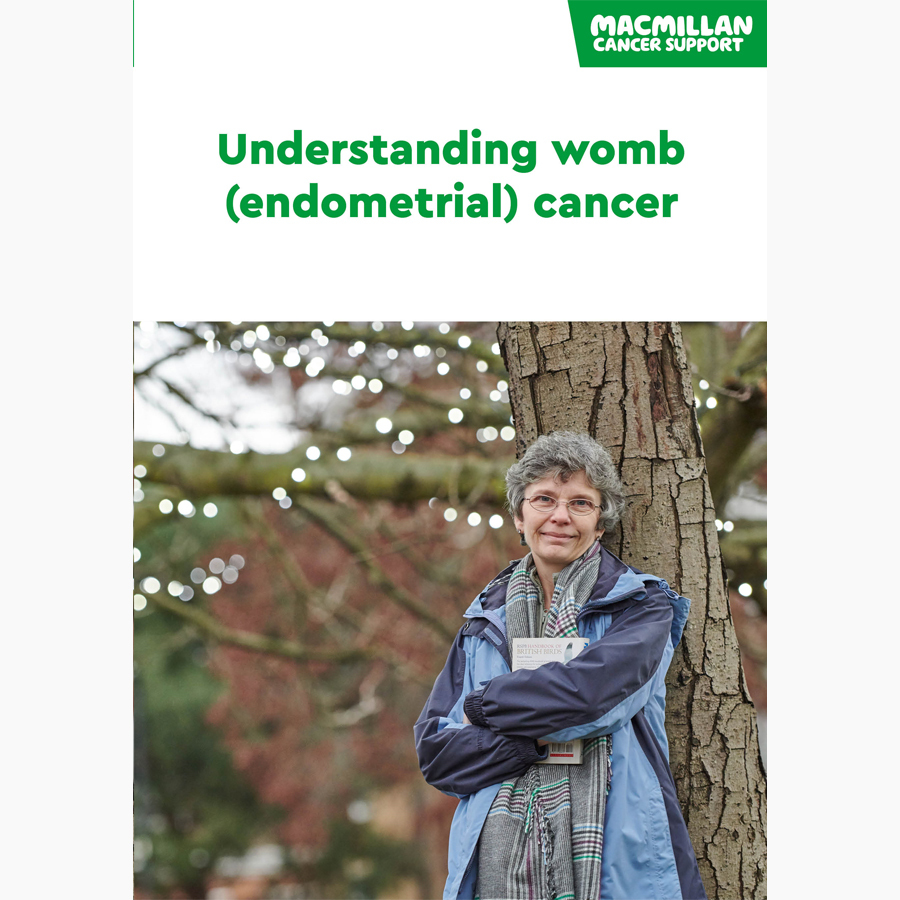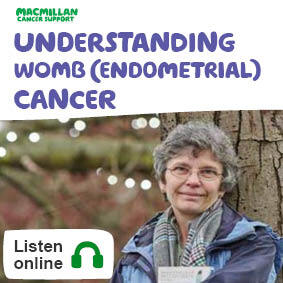What is womb cancer?
The womb (uterus) is a pear-shaped organ where a baby is carried during pregnancy. It is low in the pelvis (the area between the hips) and is supported by the pelvic floor muscles.
Most womb cancers start in glandular cells found in the lining of the womb (the endometrium). They are called endometrial cancers. There are different types of endometrial cancers. Endometrial cancer is usually diagnosed early and treated successfully. This information is about endometrial cancer.
Related pages
Booklets and resources
Symptoms of womb cancer
Usually the first sign of womb cancer is unusual vaginal bleeding. For example, this could be:
- bleeding after the menopause (this is the most common symptom)
- bleeding between periods
- heavier periods than usual (if you have not been through the menopause)
- a bloody or pink and watery vaginal discharge.
Less common symptoms are pain or discomfort in the pelvic area, or pain during sex.
If you have any unusual vaginal bleeding, always see your GP about it. Other conditions that affect the womb, such as fibroids, can also cause unusual vaginal bleeding.
Related pages
Causes of womb cancer
There are certain things that can increase the risk of developing womb cancer. These are called risk factors. Having a risk factor does not mean you will get cancer. And not having a risk factor does not mean that you will not get it.
Diagnosis of womb cancer
If you have symptoms, you usually start by seeing the GP. Your GP may do an pelvic examination (internal examination) to feel for anything unusual in the pelvis. They may also arrange:
- a blood test
- a urine sample
- a trans-vaginal ultrasound.
Your GP may refer you directly to a gynaecologist. This is a doctor who treats problems with the female reproductive system. You will be referred urgently (within 2 weeks) if you have:
- vaginal bleeding after the menopause
- a lump in your pelvis that your GP can feel
- ongoing vaginal bleeding between your periods.
The gynaecologist will explain any other tests you need to have. This may include:
- a cervical screening test, if you have not had one recently
- a biopsy.
They will also ask whether you have any close relatives with womb or bowel cancer.
Further tests for womb cancer
If you are diagnosed with womb cancer, you may have further tests. These show the position of the cancer and whether it has spread from where it started. This is called [staging]. The results of these tests help you and your doctor make decisions about your treatment. They may arrange:
Waiting for test results can be a difficult time. We have more information that can help.
Related pages
Staging and grading of womb cancer
The stage of the womb cancer describes:
- how far the cancer has grown
- if it has spread from where it started.
Grading is about how the cancer cells look under the microscope compared with normal cells.
Staging and grading of the cancer helps you and your doctor make decisions about your treatment.
Treatment for womb cancer
A team of specialists meet to talk about the best treatment for you. They are called a multidisciplinary team (MDT).
The MDT will look at many factors when planning your treatment options. These will include:
The main treatment for womb cancer is an operation to remove the womb, cervix, fallopian tubes and ovaries. This is sometimes the only treatment needed to cure the cancer. Depending on the stage and grade of the cancer, you may also be offered treatments after surgery. These can help reduce the risk of the cancer coming back.
Your doctor will explain the different treatments and their side effects. They will also talk to you about the things you should consider when making treatment decisions. You may also be invited to take part in a clinical trial.
The types of treatment you may have include:
-
Surgery
Surgery to remove the womb (a hysterectomy) is usually the main treatment for womb cancer. Sometimes surgery is used to treat womb cancer that has spread.
-
Radiotherapy
Radiotherapy uses high-energy rays to destroy cancer cells, while doing as little harm as possible to normal cells. Radiotherapy may be used to reduce the risk of cancer coming back after surgery. It may also be given as the main treatment for womb cancer or to help manage symptoms of advanced womb cancer.
-
Chemotherapy
Chemotherapy uses anti-cancer (cytotoxic) drugs to destroy cancer cells. It is sometimes used to reduce the risk of cancer coming back after surgery or radiotherapy. Or it may be used to help control cancer and relieve symptoms.
-
Hormonal therapy
The hormones oestrogen and progesterone can affect how cells in the womb lining grow. You may be offered hormonal therapy to try to shrink and control the cancer and relieve symptoms.
-
Targeted therapy and immunotherapy
Newer treatments called targeted therapy and immunotherapy may be used to treat womb cancer that has spread. These can help to control the cancer and slow down the growth. Your doctor will send a sample of the cancer cells taken during a biopsy or surgery to be tested. This helps to check which type of treatment may work best for you. Your doctor or nurse will explain if these treatments are suitable for you.
If you want to have children in the future, it is important to talk to your doctor about your fertility before you start treatment. With early-stage, low-grade cancer, it may sometimes be possible to have fertility-sparing treatment.
After womb cancer treatment
After treatment, you will probably want to get back to doing the things you did before your cancer diagnosis. But you may still be coping with the side effects of treatment and with some difficult emotions. Recovery takes time, so try not to be hard on yourself. It is not unusual to feel anxious and lonely at this time.
After your treatment, you will have regular check-ups. They will include an internal examination. These will be every few months at first. Eventually, you may only be seen once a year. If you have any problems or new symptoms in between appointments, it is important to contact your cancer doctor or specialist nurse as soon as possible.
Some people do not have routine appointments. Instead, they are asked to contact their cancer doctor or nurse if they have new symptoms, or are worried about anything. Important symptoms to be aware of are:
- bleeding from the vagina or back passage
- pain in the pelvic area
- any lumps or swellings
If womb cancer comes back in the same area, it can often be treated successfully.
You may get anxious between appointments. This is natural. It may help to get support from family, friends or a support organisation.
Macmillan is also here to support you. If you would like to talk, you can:
- call the Macmillan Support Line on 0808 808 00 00.
- chat to our specialists online.
- visit our womb cancer forum to talk with people who have been affected by womb cancer, share your experience, and ask an expert your questions.
Sex life
Womb cancer, its treatment and side effects may affect your sex life and how you feel about yourself. Some treatments can cause an early menopause. We have more information about coping with menopausal symptoms.
Well-being and recovery
Even if you already have a healthy lifestyle, you may choose to make some positive lifestyle changes after treatment.
Making small changes such as eating well and keeping active can improve your health and wellbeing and help your body recover.
Related pages
About our information
-
References
Below is a sample of the sources used in our womb cancer information. If you would like more information about the sources we use, please contact us at cancerinformationteam@macmillan.org.uk
Concin et al. ESGO/ESTRO/ESP guidelines for the management of patients with endometrial carcinoma. International Journal of Clinical Oncology. 2021. Available from www.pubmed.ncbi.nlm.nih.gov/33397713/
Royal College of Radiotherapy: Clinical Oncology. Radiotherapy dose fractionation, third edition. 2019. Available from www.rcr.ac.uk/publication/radiotherapy-dose-fractionation-third-edition
Sundar et al. BGCS uterine cancer guidelines: Recommendations for practice. European Journal of Obstetrics & Gynecology and Reproductive Biology. 2017. Available from www.bgcs.org.uk/wp-content/uploads/2019/05/BGCSEndometrial-Guidelines-2017.pdf
-
Reviewers
This information has been written, revised and edited by Macmillan Cancer Support’s Cancer Information Development team. It has been reviewed by expert medical and health professionals and people living with cancer. It has been approved by Senior Medical Editor, Professor Nick Reed, Consultant Clinical Oncologist.
Our cancer information has been awarded the PIF TICK. Created by the Patient Information Forum, this quality mark shows we meet PIF’s 10 criteria for trustworthy health information.
The language we use
We want everyone affected by cancer to feel our information is written for them.
We want our information to be as clear as possible. To do this, we try to:
- use plain English
- explain medical words
- use short sentences
- use illustrations to explain text
- structure the information clearly
- make sure important points are clear.
We use gender-inclusive language and talk to our readers as ‘you’ so that everyone feels included. Where clinically necessary we use the terms ‘men’ and ‘women’ or ‘male’ and ‘female’. For example, we do so when talking about parts of the body or mentioning statistics or research about who is affected.
You can read more about how we produce our information here.
Date reviewed
This content is currently being reviewed. New information will be coming soon.

Our cancer information meets the PIF TICK quality mark.
This means it is easy to use, up-to-date and based on the latest evidence. Learn more about how we produce our information.
How we can help





